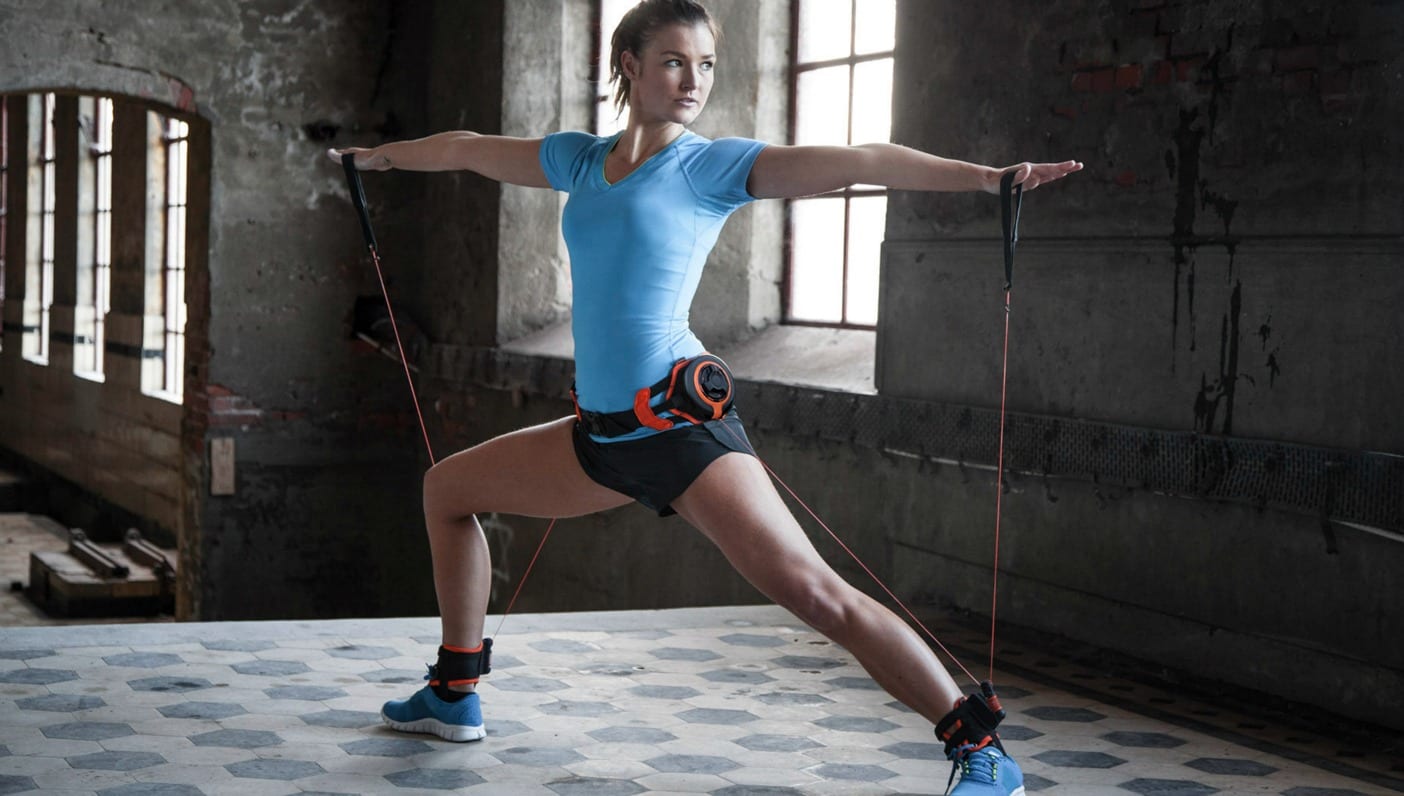
From pole dancing to trampoline and trapeze classes, Doga and aqua cycling, there’s no shortage of odd (yet still effective, right?) fitness trends saturating the wellness market.
Meet the Disq—a peculiar looking device that’s popping up in Crunch gyms on both coasts, and spicing up yoga, pilates bootcamp, and even hip-hop classes. It’s no wonder then why it’s the training device of choice for Usher, and for Madonna’s backup dancers.
The Disq operates on a pulley system—its accoutrements attached to the wearer’s waist and ankles, with cords that can be adjusted to varying degrees of resistance. Think of it as a wearable elliptical machine, allowing your bionic body to glide, pop and lock—all with a tug of the wrist. It was created in 2013 by Robbert Boekema, a Dutch speedskater, who was inspired by his mother, former Olympian Ans Schut, who eventually became his coach. Their goal was to create a resistance training device that could replace weightlifting.
The Disq quickly made a name for itself in Russia and Germany first, and is now available in over 24 countries. The popularity of the device has transformed regular workouts that to many, may seem old hat, into fresh, new (and quite challenging) routines. As if bootcamp wasn’t already tough enough.
Tired of your regular yoga practice? A reporter at The Observer recently gave Disq yoga a try:
Getting into the Disq requires some focus; after strapping it around my midsection and ankles, I had to maneuver its cords so they stretched from my waist, to the little hooks on my ankles, and then up into my hands.
Using the Disq made ordinarily easy yoga poses really, really hard. An extended side angle pose takes on a whole new element of difficulty when one’s arm must fight against resistance to reach up to the sky.
Mr. Boekkema devised a contraption that could bring strength training to any form of cardio. “Now I can train anywhere, anytime, my strength training in combination with my cardio,” Mr. Boekkema said, noting that he often wears the Disq when he goes out for runs.
And while resistance training is key to many athletes and gym rats, the Disq is not for the faint of heart. For yogis and pilates lovers, certain poses and exercises may be enough, without the added element of friction. As far as other trendy fitness crazes go, well, there might already be enough going on as is, with all the coordination, sequencing, and memorization of certain dance moves that many of these classes require.
A writer at the L.A. Times chronicled his experience:
The class is based on the Disq fitness device, a pair of retractable resistance cords on a belt that thread down through ankle-cuff pulleys and come up to hand-held grips. It’s like wearing a robot suit that makes every movement harder, with resistance as you raise, lower and punch your hands; you use knobs on the belt to dial your preferred resistance.
The movements are fluid, no-impact and fun—but the resistance takes its toll. Swept up in the beat doing chorus line kicks and biceps curls, I soon noticed my lungs heaving, my coordination failing and my sweat raining. As we moved back and forth across the floor alternating dance moves and strength exercises (kettle-bell-style squats, lunges, sideways burpees, planks to donkey kicks, and bent-leg V-ups), it began feeling like the Boot Camp From Hell. My problem: too-high resistance. Halfway through the workout, I gave in and dialed down.
So why not embody the Bionic Man for 45 minutes and try something new? Disq classes can be found in Crunch gyms in New York, Miami and Los Angeles. If your fitness regimen is feeling stale, why not add a little extra push (and pull) to your workout? Resistance is, in this case, not so futile after all.
Photo courtesy of the Disq
—
 Andrea Rice is the Practice and Community Editor for Wanderlust Media. She is also a writer and yoga teacher. Her work has appeared in The New York Times, Yoga Journal, mindbodygreen, Yoganonymous, AstroStyle, and several music magazines. Her teaching style is a blend of her love for music and intuitive movement, with emphasis on core strength. You can find her regular classes at Shambhala Yoga in Brooklyn and connect with her on Instagram and Twitter.
Andrea Rice is the Practice and Community Editor for Wanderlust Media. She is also a writer and yoga teacher. Her work has appeared in The New York Times, Yoga Journal, mindbodygreen, Yoganonymous, AstroStyle, and several music magazines. Her teaching style is a blend of her love for music and intuitive movement, with emphasis on core strength. You can find her regular classes at Shambhala Yoga in Brooklyn and connect with her on Instagram and Twitter.